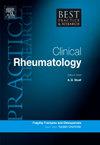2025年晶体诱发关节病的影像学研究。
IF 4.8
2区 医学
Q1 RHEUMATOLOGY
Best Practice & Research in Clinical Rheumatology
Pub Date : 2025-09-01
DOI:10.1016/j.berh.2025.102063
引用次数: 0
摘要
近年来,影像学已成为评估晶体性关节病(CIAs)的重要工具,包括痛风、焦磷酸钙沉积病和碱性磷酸钙晶体沉积。影像学的进步改善了诊断和疾病监测,使其纳入分类标准和临床指南。超声(US)、常规放射照相(CR)和双能计算机断层扫描(DECT)各有其独特的优势。US是一种广泛可及的、具有成本效益的动态工具,而DECT提供晶体特异性图像,特别有助于痛风诊断。CR虽然对早期晶体沉积不太敏感,但在评估结构损伤和慢性变化方面仍有价值。尽管取得了这些进步,但挑战依然存在。影像学结果的特异性和敏感性需要进一步验证,某些影像学特征的临床相关性存在争议。这篇综述总结了最近的发展,突出了关键优势,并讨论了尚未解决的问题,强调了未来需要研究的领域,以优化成像在cia中的应用。本文章由计算机程序翻译,如有差异,请以英文原文为准。
Imaging of crystal-induced arthropathies in 2025
In recent years, imaging has become an essential tool in the assessment of crystal-induced arthropathies (CIAs), including gout, calcium pyrophosphate deposition disease, and basic calcium phosphate crystal deposition. Advances in imaging have improved diagnosis and disease monitoring, leading to its integration into classification criteria and clinical guidelines.
Ultrasound (US), conventional radiography (CR), and dual-energy computed tomography (DECT) each offer unique advantages. US is a widely accessible, cost-effective, and dynamic tool, while DECT provides crystal-specific images, aiding particularly in gout diagnosis. CR, though less sensitive to early crystal deposition, remains valuable for evaluating structural damage and chronic changes.
Despite these advances, challenges remain. The specificity and sensitivity of imaging findings need further validation, and the clinical relevance of certain imaging features is debated. This review summarizes recent developments, highlights key strengths, and discusses unresolved issues, emphasizing areas where future research is needed to optimize imaging use in CIAs.
求助全文
通过发布文献求助,成功后即可免费获取论文全文。
去求助
来源期刊
CiteScore
9.40
自引率
0.00%
发文量
43
审稿时长
27 days
期刊介绍:
Evidence-based updates of best clinical practice across the spectrum of musculoskeletal conditions.
Best Practice & Research: Clinical Rheumatology keeps the clinician or trainee informed of the latest developments and current recommended practice in the rapidly advancing fields of musculoskeletal conditions and science.
The series provides a continuous update of current clinical practice. It is a topical serial publication that covers the spectrum of musculoskeletal conditions in a 4-year cycle. Each topic-based issue contains around 200 pages of practical, evidence-based review articles, which integrate the results from the latest original research with current clinical practice and thinking to provide a continuous update.
Each issue follows a problem-orientated approach that focuses on the key questions to be addressed, clearly defining what is known and not known. The review articles seek to address the clinical issues of diagnosis, treatment and patient management. Management is described in practical terms so that it can be applied to the individual patient. The serial is aimed at the physician in both practice and training.

 求助内容:
求助内容: 应助结果提醒方式:
应助结果提醒方式:


